Baltimore is home to a variety of bird species, ranging from the iconic Baltimore Oriole and stunning European Starling to the elusive Ruby-crowned Kinglet and vocal Tufted Titmouse.
These feathered beauties can be found in a variety of habitats throughout the city, from the bustling Patterson Park to the scenic Patapsco Valley State Park.
In this article we will take a closer look at some of the most interesting and unique birds that call Baltimore home, highlighting their unique characteristics and behaviors, as well as the best places to spot them.
Whether you’re a seasoned birder or just getting started, Baltimore is a great place to explore the world of birds. So grab your binoculars and join us as we discover what the most common birds of the area look like.
Table of Contents
Birds Of Baltimore
Common Starling
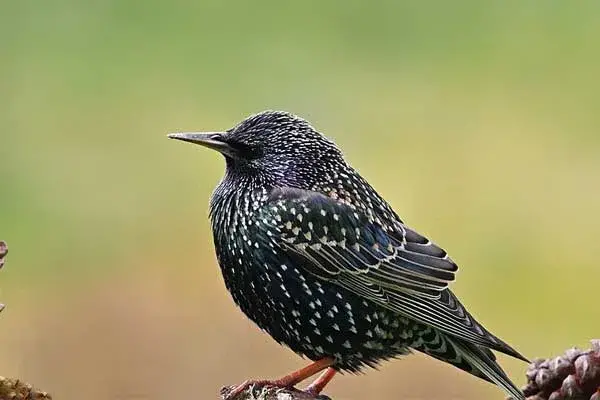
- Scientific Name: Sturnus vulgaris
- Length: 7.5–9.1 in
- Wingspan: 12-17 in
- Weight: 2-3.6 oz
Common starlings are small dark birds that can measure as little as 7.5 inches long and have a wingspan of just 12 in.
They have glossy black plumage with a metallic sheen, pink legs, and black beaks during winter that turn yellow in summer. Common starlings are easy to recognize by white dots on their black plumage during winter, short tails, triangular wings, and long, pointed beaks.
They are also known as European starlings as they are native to Europe. They were introduced to other places, including North America, where common starlings are now designated invasive species. Starlings were first seen in Baltimore in 1906 and have since then spread throughout the area.
They are common around woodlands, parks, backyards, and urban places year-round, especially in areas where people live. Whether you visit Herring Run Park, Druid Hill Park, or move south to Fort McHenry National Monument and St. Mary’s Park, you will have no problem spotting these birds.
Common starlings are very loud and social birds that can live in huge flocks; winter roosts can include from a few thousand to several million birds.
Common Starling Song | Source: Vladimir Yu. Arkhipov, Arkhivov, CC BY-SA 3.0, via Wikimedia Commons
Baltimore Oriole
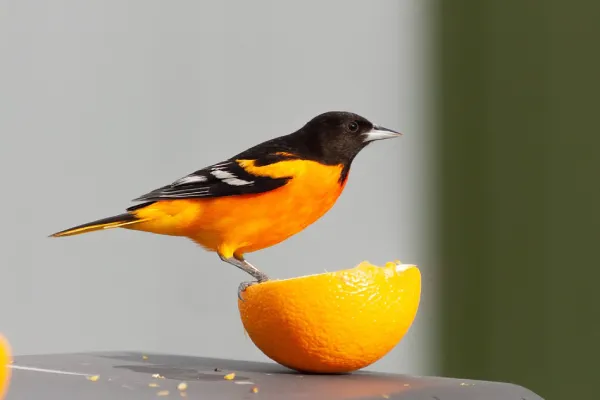
- Scientific Name: Icterus galbula
- Length: 6.7-8.7 in
- Wingspan: 9.1-12.6 in
- Weight: 0.79-1.48 oz
Baltimore orioles are one of the prettiest and most brilliantly colored songbirds of Baltimore. These tiny blackbirds got their names after the resemblance to the crest of Lord Baltimore’s coat of arms, a 17th-century English nobleman who also named the city.
Baltimore orioles are state birds of Maryland and can be identified by their sturdy bodies, long tails, and pointy beaks. Males look stunning with their bright orange plumage, black heads, and conspicuous white wing bars; females can have yellow to bright orange underparts and darker wings.
They are summer residents in Baltimore and can be best seen there from May to September before they move to northern South America. You are most likely to find Baltimore orioles around Jones Falls Trail, Fort McHenry National Monument and Historic Shrine, Carrie Murray Nature Center, or Joseph E. Lee Park.
Listen for their rich whistling song around open woodlands, forest edges, orchards, parks, and riversides. Baltimore orioles love to visit backyard feeders; attract them by adding nectar and ripe dark-colored fruits (mulberries, cherries, or grapes).
Baltimore Oriole Song | Source: Jonathon Jongsma, CC BY-SA 3.0, via Wikimedia Commons
Lesser Scaup

- Scientific Name: Aythya affinis
- Length: 15-19 in
- Wingspan: 27–31 in
- Weight: 1-2.4 lb
Lesser scaups are small diving ducks found in North America. People also call them “little bluebills” or “broadbills” because of their distinctive bluish bills with black tips.
Male lesser scaups are black and white with iridescent black heads (green or purple in the right light), white sides, black rumps, black and white barred backs, and yellow eyes. Females are dark brown above, white below, brown on the sides, and have a white ring around their bills.
They often form large flocks and inhabit lakes, ponds, and rivers. Lesser scaups are most common in Baltimore during the non-breeding season, from October to April. Visiting the waters of Druid Hill Park, Hanlon Park, Middle Branch Park, or Fort McHenry will give you a good chance of spotting these birds in the area.
Lesser scaups are the most widespread species of diving ducks in North America, with an estimated population of slightly under 4 million.
Mourning Dove

- Scientific Name: Zenaida macroura
- Length: 11-13 in
- Wingspan: 17-19 in
- Weight: 4-6 oz
Mourning doves are one of the most abundant and widespread North American birds; they are also very popular gamebirds. They were named after the sad cooing sounds they make while singing.
Mourning doves have light brown bodies, black spots on their wings, long tails, and iridescent necks. They can be also identified by their different vocalizations: distinctive “coo-woo-woo” calls when attracting females, soft greeting “ork” calls, and short “roo-oo” alarm calls.
Mourning Dove Song | Source: Jonathon Jongsma, CC BY-SA 3.0, via Wikimedia Commons
Mourning doves are permanent residents of Baltimore and you will have no problem finding them there around suburban yards and parks. Lake Roland, Herring Run Park, St. Helena Park, Green Mount Cemetery, and Gwynns Falls Trail, are just a few places where you can find them.
They are monogamous birds where both parents incubate the eggs and raise the young – mourning doves are excellent at breeding and can raise up to 12 young per year which explains their huge population of around 167 million birds.
Ruby-throated Hummingbird
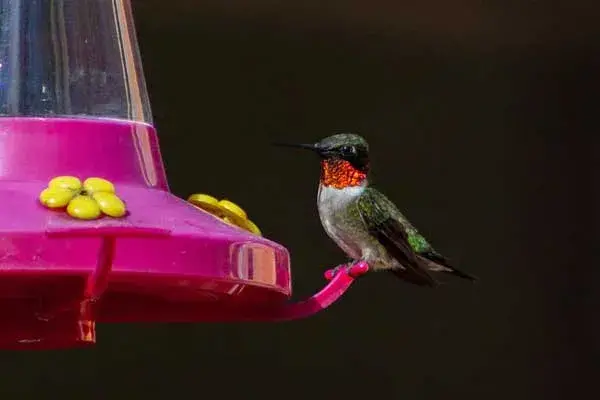
- Scientific Name: Archilochus colubris
- Length: 2.8-3.6 in
- Wingspan: 3.1-4.3 in
- Weight: 0.07-0.2 oz
Ruby-throated hummingbirds are one of the smallest birds in North America. They can have a wingspan of as little as 3.1 inches and weigh less than a penny (0.07 oz)!
Males have metallic emerald green upperparts, grayish-white underparts, black wings, and a gorget (throat patch) of iridescent ruby red. Their tails are forked. Females are larger than males, have slightly shorter beaks, and have white throats.
They are one of the most common hummingbirds found east of the Mississippi River in the USA. Ruby-throated hummingbirds can be seen in Baltimore from April to October before they depart to southern Florida, Mexico, and Central America for the winter. Baltimore Inner Harbor, Quarry Lake, Green Mount Cemetery, and Herring Run Park, are just a few places where you can see them in the area.
To attract these birds with red necks to your backyard, you can set up hummingbird feeders or plant tubular flowers. They are quite bold and might even feed at hanging plants and feeders on your porch or next to your windows!
Ring-billed Gull

- Scientific Name: Larus delawarensis
- Length: 16.9-21.3 in
- Wingspan: 41.3-46.1 in
- Weight: 10.6-24.7 oz
Ring-billed gulls are medium-sized gulls with white bodies, gray wings, yellow eyes, and yellow legs. They got their name from the dark rings on their relatively short beaks.
Ring-billed gulls are permanent residents and are easy to spot throughout the year. Visit Druid Hill Park, Fort McHenry, Chinquapin Run Park, Hanlon Park, or Fort Holabird Park, to spot these gulls in Baltimore.
They are common around urban, suburban, and agricultural areas, including reservoirs, lakes, ponds, landfills, parking lots, and shopping malls. When winter comes, they can be seen around docks, wharves, and harbors.
Ring-billed gulls are omnivores and also feed on insects, fish, grain, eggs, earthworms, and rodents. They are often called the “fast food gulls” because they can be often seen around fast-food restaurants scavenging for food.
Ring-billed Gull Call | Source: Jonathon Jongsma, CC BY-SA 3.0, via Wikimedia Commons
Caspian Tern

- Scientific Name: Hydroprogne caspia
- Length: 19–24 in
- Wingspan: 50–57 in
- Weight: 1.1-1.72 lb
Caspian terns are among the largest terns in the world. They are easily recognizable by their enormous heads, coral-red beaks, shallowly forked tails, and deep, raspy calls. These terns are white overall with pale gray upperwings.
They got their name from the early associations with the Caspian Sea where Caspian terns are fairly common even today. These birds are very aggressive when defending their breeding colony. They will pursue, attack, and chase away potential predatory birds, and even bite people on their heads if they invade their space.
Caspian terns are fairly common in Baltimore from April to November. Look for them around Druid Hill Park, Inner Harbor, and Masonville Cove.
Caspian terns will hover high over the water, scanning for fish. When they spot one, they will fly down rapidly and dive to catch it. They also occasionally feed on large insects, the young and eggs of other birds, and some rodents.
Great Blue Heron

- Scientific Name: Ardea herodias
- Length: 36–54 in
- Wingspan: 66–79 in
- Weight: 4-7.9 lb
Great blue herons are one of the biggest blue birds in the world. And with a wingspan of up to 6.6 ft, these massive birds are hard to miss.
Great blue herons are blue-gray and have large yellow-orange beaks, short black plumes on their heads, and black and chestnut patterns on the shoulders. During the flight, they will hold their neck in an S-shape with legs trailing behind.
They are permanent residents of Baltimore and can be seen there throughout the year. In case you go looking for great blue herons, visit Chinquapin Run Park, Stony Run Park, Gwynns Falls Trail, Druid Hill Park, or Swann Park.
You will spot them stalking fish with their scissors-like beaks in marshes, bays, ponds, and rivers. They nest in colonies called heronries that can occasionally have more than 500 nests!
Turkey Vulture
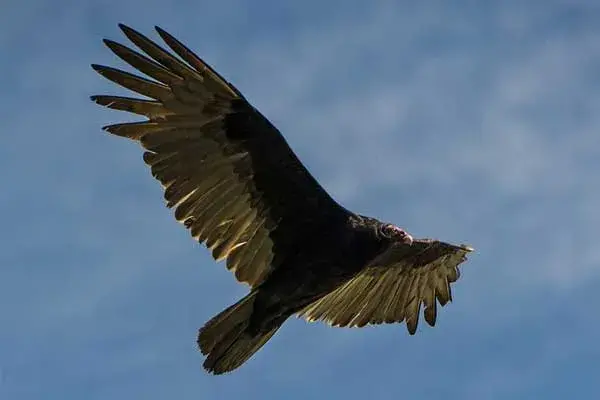
- Scientific Name: Cathartes aura
- Length: 24-32 in
- Wingspan: 63-72 in
- Weight: 1.8-5.3 lb
Turkey vultures are the largest vulture species found in Baltimore. On average, they measure between 24 and 32 inches in length and have a wingspan of approximately 5 to 6 feet.
These birds are also known as turkey buzzards, or just buzzards, and got named for their resemblance to turkeys, but they are not closely related.
Turkey vultures are permanent residents of Baltimore and most of Maryland and can be seen there year-round. Lake Roland, Hanlon Park, Herring Run Park, Winans Meadow, Fort McHenry, or even Double Rock Park just outside of Baltimore, are some great places to spot turkey vultures.
With their habit of soaring on thermal updrafts, dark plumage, bare red heads, and white legs, turkey vultures are hard to miss in the sky. Look for their silvery flight feathers that are contrasted with dark wing linings while they fly.
Using their keen vision and sharp sense of smell, turkey vultures can locate carrion easily. They are scavengers, and they feed primarily on the carcasses of dead animals. You will often spot them sitting in trees on the sides of roads waiting for their next meal.
Because of their extremely strong stomach acids, turkey vultures can eat and digest carcasses tainted with anthrax, tuberculosis, and rabies, without getting sick. They lack a syrinx (the vocal organ) which makes them voiceless; all turkey vultures can do is hiss, whine, and grunt.
Turkey Vulture Call | Source: G. McGrane, Public domain, via Wikimedia Commons
Bald Eagle

- Scientific Name: Haliaeetus leucocephalus
- Length: 28-40 in
- Wingspan: 70.8-90.5 in
- Weight: 6.6-13.9 lb
Bald eagles are one of the largest eagles in North America. They range from 28 to 40 inches long and have a wingspan of up to 7 feet 7 inches.
These large raptors were selected in 1782 as the national symbol of the United States and can be identified by their brown bodies, white heads and tails, and yellow legs and beaks. Before attaining these characteristics around the age of five, bald eagles are mostly dark brown with varying amounts of white mottling.
Baltimore City’s Masonville Cove is home to the first known pair of nesting bald eagles. These eagles have been wintering for several years now in the area.
Bald eagles build one of the largest nests of any North American bird – the largest recorded one was in Florida and measured 10 feet wide and 20 feet deep.
These magnificent raptors are hard to miss as they soar through the air with their 7.7-foot-wide wingspan. Bald eagles are carnivores and opportunistic feeders that primarily consume fish they snatch from the water with their sharp talons.
If you want to entertain yourself a bit, check out this article where you can see what bald eagles would look like if they had no beaks.
Red-tailed Hawk
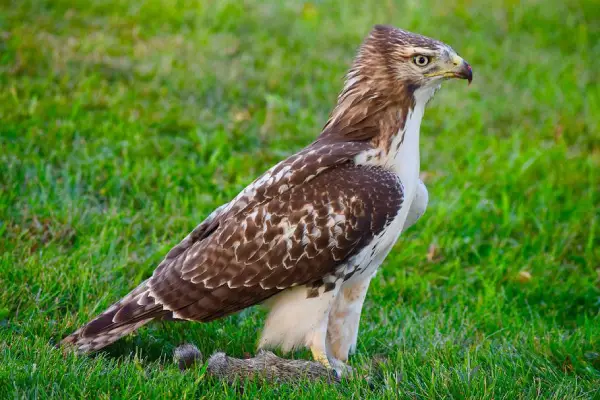
- Scientific Name: Buteo jamaicensis
- Length: 18–26 in
- Wingspan: 55 in
- Weight: 1.5-3.5 lb
Red-tailed hawks are large birds with broad rounded wings and short wide tails. There are several variations of their colors; most are brown with light bellies, streaky breast bands, and rusty tails. Females tend to be larger than males.
These raptors can be seen throughout the year in Baltimore, in almost every habitat with open areas and patches of trees or other elevated perches. Look for red-tailed hawks in Wyman Park, Patterson Park, Herring Run Park, Cylburn Arboretum, and Hanlon Park, among other places.
Red-tailed Hawk Call | Source: Jonathon Jongsma, CC BY-SA 3.0, via Wikimedia Commons
You will often see them sitting perched near a roadside or soaring in the sky and looking for prey. They can spot a mouse from 100 feet in the air and will grab it using their almost inch-and-a-half-long talons.
Red-tailed hawks are legally protected in the United States by the Migratory Bird Treaty Act and you can’t hunt them. There are 14 subspecies of these Northeastern birds.
Barred Owl
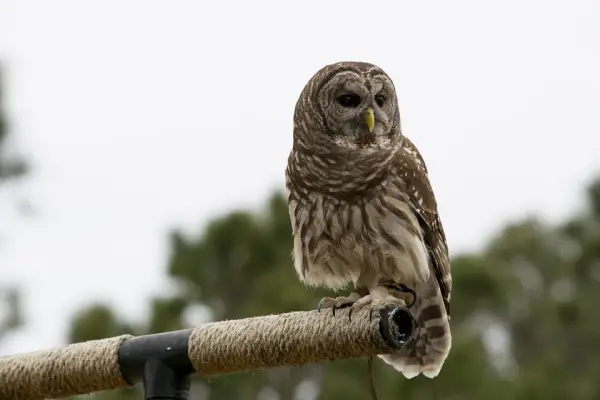
- Scientific Name: Strix varia
- Length: 16-25 in
- Wingspan: 38-49 in
- Weight: 1.3-2.5 lb
Known under several names (northern barred owls, striped owls, or more informally, hoot owls), barred owls are large birds with mottled brown and white plumage.
They can be identified by their yellow beaks, absence of ear tufts, and hoots that sound like “who cooks for you, who cooks for you all” and that can be heard almost half a mile away. Barred owls also have large and dark brown, almost black eyes.
Barred Owl Call | Source: Jonathon Jongsma, CC BY-SA 4.0, via Wikimedia Commons
They are native to eastern North America and are found mostly around woods and swamps where they hunt for insects, small mammals, crayfish, and crabs. Barred owls are year-round residents of Baltimore and can be seen there around Druid Hill Park, Patterson Park, Stony Run Park, Winans Meadow, and Federal Hill Park, among other places.
Barred owls will nest in tree holes or use abandoned nests of other animals, from red-tailed hawks to squirrels. After they establish nests, barred owls become very territorial and aggressive – they will chase away intruders by hooting aggressively or attacking them with their sharp talons!
Red-bellied Woodpecker
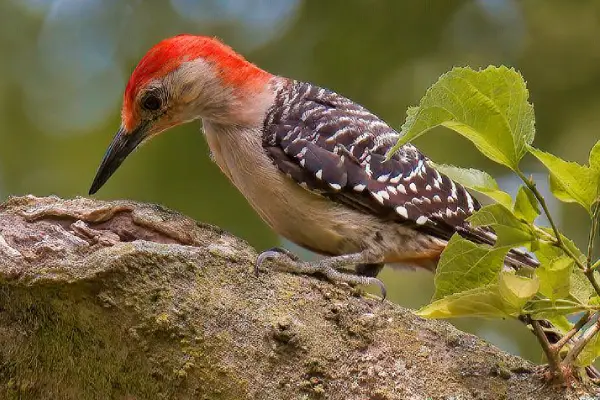
- Scientific Name: Melanerpes carolinus
- Length: 9-10.5 in
- Wingspan: 15-18 in
- Weight: 2-3.2 oz
Red-bellied woodpeckers are medium-sized woodpeckers from the eastern US. They have striped black and white backs, grayish underparts, red napes, and red on the center of their bellies; males are red from the top of their heads to the beaks while the females are only red on their napes.
Red-bellied woodpeckers can be seen around the woods and urban areas of Baltimore year-round. They are rather noisy and use several vocalizations.
Red-bellied woodpeckers’ most common call is a high-pitched “kwill” or “churr.” They will often make drumming sounds by tapping with their beaks on hollow trees or roofs to attract females.
Red-bellied Woodpecker Call | Source: G. McGrane, Public domain, via Wikimedia Commons
Males will start digging their nests in dead tree trunks and softly tap on the tree to attract females; if interested, they will join them, and the pair will finish the nest together. Females will then lay 3-5 eggs that both parents incubate.
Attract red-bellied woodpeckers to your backyard by adding sunflower seeds and different nuts to your bird feeder; add suet during winter as they are fond of it.
Eastern Kingbird
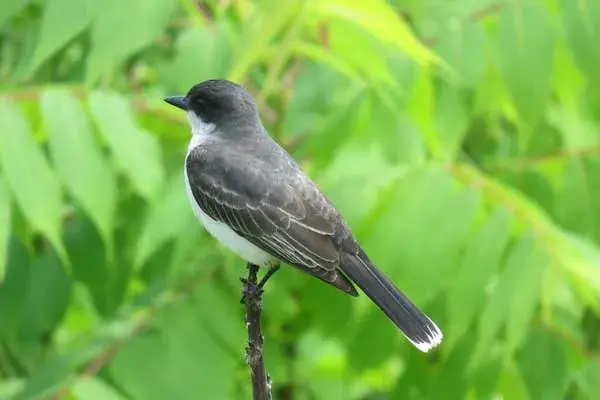
- Scientific Name: Tyrannus tyrannus
- Length: 7.5–9.1 in
- Wingspan: 13-15 in
- Weight: 1.2–1.9 oz
Eastern kingbirds are large flycatchers found in North, Central, and South America. They live in the open country, farms, and fields; areas that have bushes and scattered trees where they can perch while foraging for insects.
The name “kingbird” comes from the birds’ crowns. Eastern kingbirds also have dark gray-black plumage, white underparts, dark caps on their heads, and white bands at the tips of their tails.
They are fairly common in Baltimore and can be seen there from May to September. Some birding spots to see eastern kingbirds there include Oriole Park at Camden Yards, Baltimore Inner Harbor, Druid Hill Park, and Herring Run Park.
They breed across the entire North America, nest in trees and shrubs, lay 2-5 cream-colored eggs with reddish spots, and migrate to winter in South America, primarily northwestern Amazonia.
During their breeding season, they are very aggressive and territorial and will chase away any bird that enters their territories, including large ones like hawks and crows.
Eastern kingbirds have a song that consists of high, sputtering notes; their calls include the high-pitched “kit-kit” and “dzee-dzee” sounds.
Eastern Kingbird Call | Source: Jonathon Jongsma, CC BY-SA 3.0, via Wikimedia Commons
They will often perch on wires, watch for large insects, and make quick flights to snatch them. Eastern kingbirds also feed on berries and fruit, mainly during winter.
White-eyed Vireo
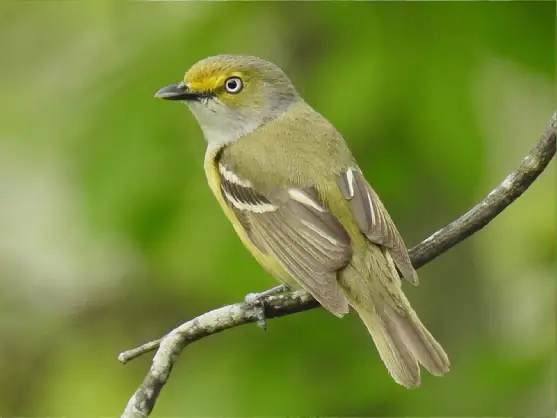
- Scientific Name: Vireo griseus
- Length: 4.3-5.1 in
- Wingspan: 6.7 in
- Weight: 0.3-0.5 oz
White-eyed vireos are extremely small songbirds that were named after their white irises.
You will identify white-eyed vireos by their olive-green upperparts, white underparts, yellow foreheads, green sides, gray necks, and dark wings.
They are breeding residents of Baltimore and can be seen in woodlands and brushy forest undergrowths from April to October. You will find white-eyed vireos around Fort McHenry National Monument, Patterson Park, Druid Hill Park, St. Mary Cemetery, or Gwynns Falls Leakin Park.
These shy birds love to stay in tree understory and out of sight but will sing the whole day to let you know they are there. White-eyed vireos have a song that consists of rapid 6-7 notes that start and end with a sharp “chick“.
White-eyed Vireo Song | Source: G. McGrane, Public domain, via Wikimedia Commons
They are omnivores that mainly feed on insects during summer and add berries to their diets when the winter comes. White-eyed vireos have an interesting way of bathing: they will rub their bodies against wet leaves in the morning.
American Robin

- Scientific Name: Turdus migratorius
- Length: 9-11 in
- Wingspan: 12-16 in
- Weight: 2.7 oz
American robins are one of the most widely distributed backyard birds in Baltimore. They are common around forests, parks, woodlands, and gardens of the city, throughout the year.
These large songbirds have a population of over 370 million birds in North America. Males can be identified by their black heads, yellow beaks, and brick-red breasts, while females are slightly duller and have brown heads.
Outside of the breeding season, American robins like to form large flocks of birds, sometimes up to 10,000 individuals. Their song is described as a “cheery” carol; these birds will also sing when storms approach and when they have passed.
American Robin Song | Source: National Park Service, Public domain, via Wikimedia Commons
American robins are the state birds of Connecticut, Michigan, and Wisconsin. They are omnivores that feed on invertebrates and fruit and lay 2-3 clutches of 3-4 light blue eggs per year.
Blue Jay

- Scientific Name: Cyanocitta cristata
- Length: 9-12 in
- Wingspan: 13-17 in
- Weight: 2.5-3.5 oz
These large nonmigratory birds are common around forests, woods, parks, and other urban areas with large oak trees. Blue jays are widespread in Baltimore and can be seen there year-round.
You will easily identify them by a mix of black, blue, and white plumage above that is white or light gray underneath. They also have bright blue wings with white spots – males and females look the same.
Blue jays are not state birds in the USA but are mascots of a Major League Baseball team called the Toronto Blue Jays. These songbirds are highly intelligent and can use tools and imitate the sounds of predators.
They might also mimic the sounds of hawks when approaching a feeding site to drive away other birds. Blue jays are very noisy birds that mate for life and work together to build a nest for their young.
Blue Jay Call | Source: G. McGrane, Public domain, via Wikimedia Commons
Make sure to notice the crests on top of their heads that can be used to indicate the birds’ mood – when agitated, the crest goes up and when frightened, the crest goes down.
Tufted Titmouse
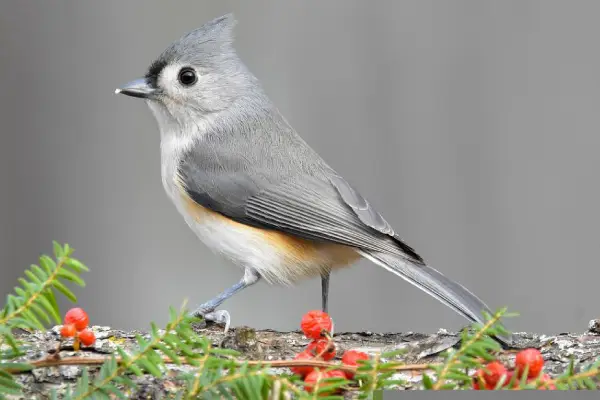
- Scientific Name: Baeolophus bicolor
- Length: 5.5–6.3 in
- Wingspan: 8-10 in
- Weight: 0.6–0.9 oz
Tufted titmice are small and widespread songbirds. They are common in areas ranging from forests and parks to suburbs and can be seen throughout the year in Baltimore.
You will recognize a tufted titmouse by its gray plumage, black eyes, a dark spot on the forehead, crested head, and fawn flanks.
Listen for their song that’s usually described as a whistled “peter-peter-peter.” Some estimates claim that there are over 8 million of these birds in existence today.
Tufted Titmouse Song | Source: G. McGrane, Public domain, via Wikimedia Commons
Tufted titmice are omnivores and feed on berries, nuts, seeds, fruits, and insects. They are common winter visitors to bird feeders; make sure to add sunflower seeds if you want to attract one. The bird will first scouts a feeder from cover, fly in to grab a seed, and then fly back to cover to eat it.
Ruby-crowned Kinglet

- Scientific Name: Regulus calendula
- Length: 3.5-4.3 in
- Wingspan: 6.3-7.1 in
- Weight: 0.2-0.4 oz
Ruby-crowned kinglets are miniature birds that measure 3.9 inches on average in length and weigh just 0.3 ounces!
They are one of the smallest North American songbirds and can be identified by their olive-green colors, two white wing bars, and white eye-rings. Males also have red crown patches, which are usually concealed.
Ruby-crowned kinglets can be found throughout North America, breeding in the northeastern USA during summer and darting low in woods and thickets of the southern USA during winter. They are most common in Baltimore from September to May. Patterson Park, Druid Hill Park, St. Mary Cemetery, Jones Falls, and Gwynns Falls Trail are some of the places where you might spot them in the area.
Despite their miniature size, these tiny green birds make very loud and complex sounds. Ruby-crowned kinglets build cup-shaped nests and have the largest clutch of any North American passerine for their size. A female may lay up to 12 eggs and that entire clutch can weigh as much as the female herself.
Ruby-kinglet Call | Source: G. McGrane, Public domain, via Wikimedia Commons
House Wren
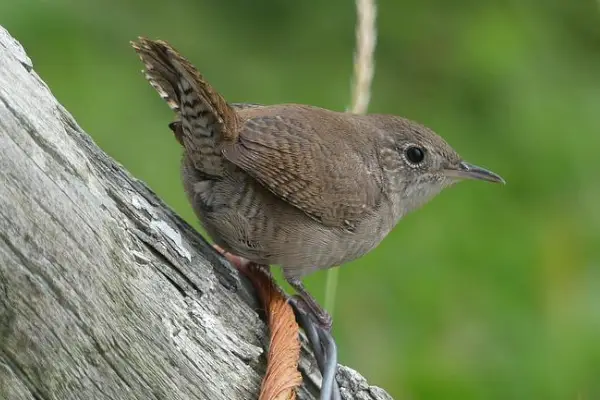
- Scientific Name: Troglodytes aedon
- Length: 4.3-5.1 in
- Wingspan: 5.9 in
- Weight: 0.35-0.42 oz
House wrens are common small backyard birds that were named after their tendency to nest around human homes. They measure as little as 4.3 inches in length and can weigh less than 0.4 ounces.
These tiny songbirds have flat heads, curved beaks, pinkish or gray legs, and short tails that are usually held cocked. Identify house wrens also by their brown upperparts, grayish underparts, and barrings on the wings and tails.
House wrens are breeding residents of Baltimore and can be best seen there from May to September, although some birds might be spotted there in December. Look for them around forests, fields, and gardens.
They are also known for their rush-and-jumble songs. House wrens will often make different harsh sounds: churrs, chatters, rattles, and scolds.
House Wren Call | Source: Jonathon Jongsma, CC BY-SA 3.0, via Wikimedia Commons
If you want to attract house wrens to your yard, all you need to do is to add a birdhouse; they rarely visit bird feeders and prefer hunting insects.
Summary
This concludes our list of common birds in Baltimore. Some examples include blue jays, American robins, bald eagles, common starlings, Baltimore orioles, and many others. Hopefully next time you see these birds, you will recognize any of them with ease!